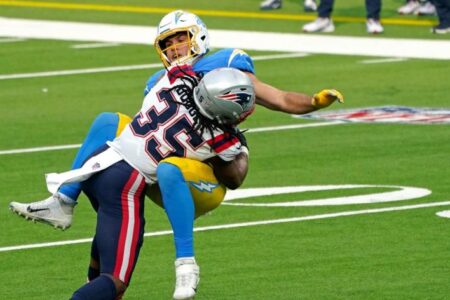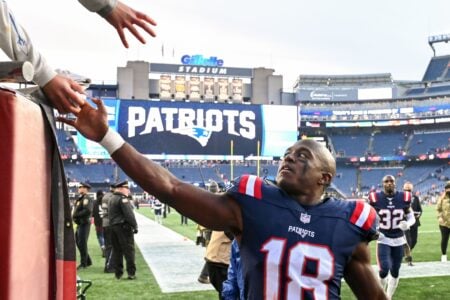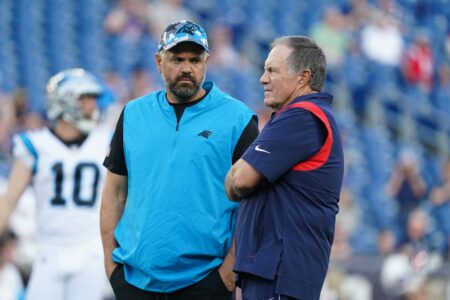Just want to share a different perspective on the Patriots' power. We do some computer modeling and it shows some aspects of the Pats' that may or may not be correct, but intriguing for thought.
A. Exhibit 1A and 1B show a model for Pats' scoring capability (both for and against) vs. a hypothetical NFL opponent with an average O, D, and ST. The bar charts are actual data to date. The curves are not from the data. They are computerized model based on the Pats' plays. Notice that the data of the "for-score" (green bars in Exh. 1A) is to the right of the green curve, which may indicate that the Pats have been scoring higher than expected, probably from playing with sub-par defense.
The red bars and the red curves in Exh. 1B seem to be a bit more consistent, which may indicate that the Pats have been playing more even offense.
B. But more interestingly, the Eagles game result is not about "blue print" or as shocking as what one may think. Exhibit 2 shows the Pats' win margin, and while one can expect the Pats to win by ~19 pts against an average team, the chance for such a team to pull an offset is ~6.5%, which is not that small, and to pull within 3 points is 10%.
At the same time, winning by 40 pts or more is also not probable. But one can be selective to think that the Pats should do that all the time while thinking that winning by 3 is rare. The Eagles are better than average, and after the game with update play capability, they can pull within 3 pts with the Pats at 18% chance. So, the Eagles game is not any more surprising than the Redskins and Bills' games.
C. Finally, what is most intriguing is seen in Exh. 3 that compares the Pats O and D. Here, the scoring is calculated only for net O and net D, not including special team. The Pats' O did not score as high as we think. For example, they scored only net 35 pts in the Miami game (7 pts from special team and minus 7 pts INT returned). The D is not as bad as it seems, since they gave up 28 pts to the Eagles, but scored 7 pts to their credit for a net 21. The model is consistent with both cases.
The most intriguing suggestion is shown in Exh. 3C, when the Pats' O and D are normalized so that they can be compared with each other. Here, the Pats' O curve is narrow, which means that it is much more consistent than the Pats' D, which has a broad curve. In other words, in games like the Eagles, the Pats' O did its job as expected (might be a bit on the low side), but the Pats' D can be more "Jekyll-and-Hyde". They can shut out or give up huge # of points. Their performance curve is much worse vs. better defenses. If there had been a TBrady clone driving the Eagles on the last drive, I think the Eagles would have won. In other words, TBrady + Moss+Welker+Stallworth et al would have lost to TBrady +Eagles offense.
Consistency is really the power of team. The long right tail of the red D curve in Exh. 3B and 3C means that there is a very significant risk they'll give up 30 or 40 pts a game, a la 2006 AFCCG.
I believe that the Pats will go 19-0, but if they lose one game (regular or play off), this computer model indicates that it will be most likely on the D performance, not the O. Thus, the Ravens should not worry us, but Green Bay and Favre should be cause for concern.
A. Exhibit 1A and 1B show a model for Pats' scoring capability (both for and against) vs. a hypothetical NFL opponent with an average O, D, and ST. The bar charts are actual data to date. The curves are not from the data. They are computerized model based on the Pats' plays. Notice that the data of the "for-score" (green bars in Exh. 1A) is to the right of the green curve, which may indicate that the Pats have been scoring higher than expected, probably from playing with sub-par defense.
The red bars and the red curves in Exh. 1B seem to be a bit more consistent, which may indicate that the Pats have been playing more even offense.
B. But more interestingly, the Eagles game result is not about "blue print" or as shocking as what one may think. Exhibit 2 shows the Pats' win margin, and while one can expect the Pats to win by ~19 pts against an average team, the chance for such a team to pull an offset is ~6.5%, which is not that small, and to pull within 3 points is 10%.
At the same time, winning by 40 pts or more is also not probable. But one can be selective to think that the Pats should do that all the time while thinking that winning by 3 is rare. The Eagles are better than average, and after the game with update play capability, they can pull within 3 pts with the Pats at 18% chance. So, the Eagles game is not any more surprising than the Redskins and Bills' games.
C. Finally, what is most intriguing is seen in Exh. 3 that compares the Pats O and D. Here, the scoring is calculated only for net O and net D, not including special team. The Pats' O did not score as high as we think. For example, they scored only net 35 pts in the Miami game (7 pts from special team and minus 7 pts INT returned). The D is not as bad as it seems, since they gave up 28 pts to the Eagles, but scored 7 pts to their credit for a net 21. The model is consistent with both cases.
The most intriguing suggestion is shown in Exh. 3C, when the Pats' O and D are normalized so that they can be compared with each other. Here, the Pats' O curve is narrow, which means that it is much more consistent than the Pats' D, which has a broad curve. In other words, in games like the Eagles, the Pats' O did its job as expected (might be a bit on the low side), but the Pats' D can be more "Jekyll-and-Hyde". They can shut out or give up huge # of points. Their performance curve is much worse vs. better defenses. If there had been a TBrady clone driving the Eagles on the last drive, I think the Eagles would have won. In other words, TBrady + Moss+Welker+Stallworth et al would have lost to TBrady +Eagles offense.
Consistency is really the power of team. The long right tail of the red D curve in Exh. 3B and 3C means that there is a very significant risk they'll give up 30 or 40 pts a game, a la 2006 AFCCG.
I believe that the Pats will go 19-0, but if they lose one game (regular or play off), this computer model indicates that it will be most likely on the D performance, not the O. Thus, the Ravens should not worry us, but Green Bay and Favre should be cause for concern.
Attachments
Last edited:




















